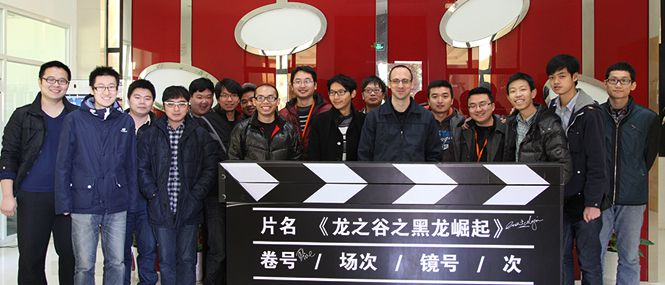One of the great things about fxphd is being able to connect with artists and students from around the world and help them take their careers to the next level. We were excited recently to visit China again for three weeks and deliver visual effects training with our Chinese language partner Mili Pictures Worldwide. Mili is currently working on its first 3D animated feature, Dragon Nest, to be released in 2014. fxphd Prof. Magno Borgo, from Boundary Visual Effects, talks about his travels.
Borgo began in Suzhou, west of Shanghai, where around 200 of Mili’s artists are working on Dragon Nest. “The infrastructure looks great, big renderfarm, nice working stations, small theater for watching dailies,” says Borgo. They also have a partnership with a Chinese university developing a new GPU render engine.”

For a few years now we’ve heard about the development and rise of places like India and China for VFX and animation production. So how was Mili looking to Borgo? “From what I saw the quality of the work they’re doing is great,” he says. “Great visuals, good animation/compositing, nice hair/particle fx. I don’t know any studio in Brazil (where Borgo is from) at this size, that many people, or infrastructure, it’s impressive! Still, when I asked them if they were doing R&D they said, ‘We’re too small to have that!’ Funny.”
Borgo taught Mili’s compositing team of 20 artists first, using case studies from fxphd’s VFX220 – Feature Film VFX Supervision course with The Hunger Games vfx supe Sheena Duggal), and also courses such as Charles Poynton’s DCT302 Advanced Color Theory and ACES Workflow. He also ran through various Nuke features.

Borgo delivered the classes in English, and had a Chinese interpreter (who was actually Mili’s FX department lead) present to translate to the artists. This was one of the most challenging aspects of the course, since it inherently involved pausing between sections for the translation to occur, not to mention some of the complicated concepts that come with visual effects.
Borgo’s assessment of the artists at Mili was that they “have raw power, but a gap in knowledge. When I asked then where they learned Nuke – they have been using it for around 2-3 years – they told me…a little bit on college, the rest was by themselves.” Some of the specific challenges the artists faced, according to Borgo, were having to read Nuke manuals in English and finding relevant information on discussion lists or forums. Also, YouTube and Vimeo videos are not available in China.

To help the artists while he was there, Borgo – who is a certified NUKE trainer – checked out their production pipeline and included problem solving tips and tricks into his course on the fly. “The subjects that attracted most interest were deep compositing, new subject for them, that would solve a lot of their fx smoke/crowd compositing problems. Also colorspaces, gamma and the ACES workflow. Another area of interest was environment/coverage mapping to 3D project matte painting.”
In his second and third weeks of teaching, Borgo then visited Changshu Institute of Technology to run a ‘101 course on compositing. “We went through the basics: 3D render passes, rotoscope, tracking, painting, warping, color correction. They had definitely fun, the objective was to give them the basics without going too intense on the technical side, show the software capabilities and perhaps inspire them to follow the compositing career in the future.”

For Borgo, expanding his teaching horizons to China proved to be a unique experience. “It was totally different from what I’m used to, I came here with an open mind, trying to absorb as much as possible. I’m learning a little bit of spoken mandarin, but reading/writing is daunting, too complex for beginners.”
“The Chinese people have been very kind,” he adds, “trying really hard to make me feel welcome and comfortable. Definitely discrete, ambitious and hard working. In big cities sometimes you may think you are in some another country, everyone with their iPhones and wearing foreign brands, shopping malls and well know food franchises everywhere.”

Interestingly, Borgo’s own experience of growing up and working in Brazil somewhat matched that of China. “Everyday I chat with people and the more I learn the more I feel that Brazil and China look very alike, the very same developing country problems and issues. City infrastructure is impressive, everything is big: roads, streets, bridges, viaducts. Street traffic is crazy, hehe!”
But, he says, “I can definitely confirm that Chinese food in Brazil is not the real one, it’s so different! Doing my best to try everything, even the creepy stuff (duck tongue, anyone?). I know people that would not last one week on a Chinese diet, craving for eastern food, but I’m doing great.”
